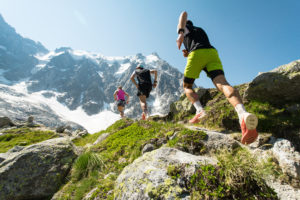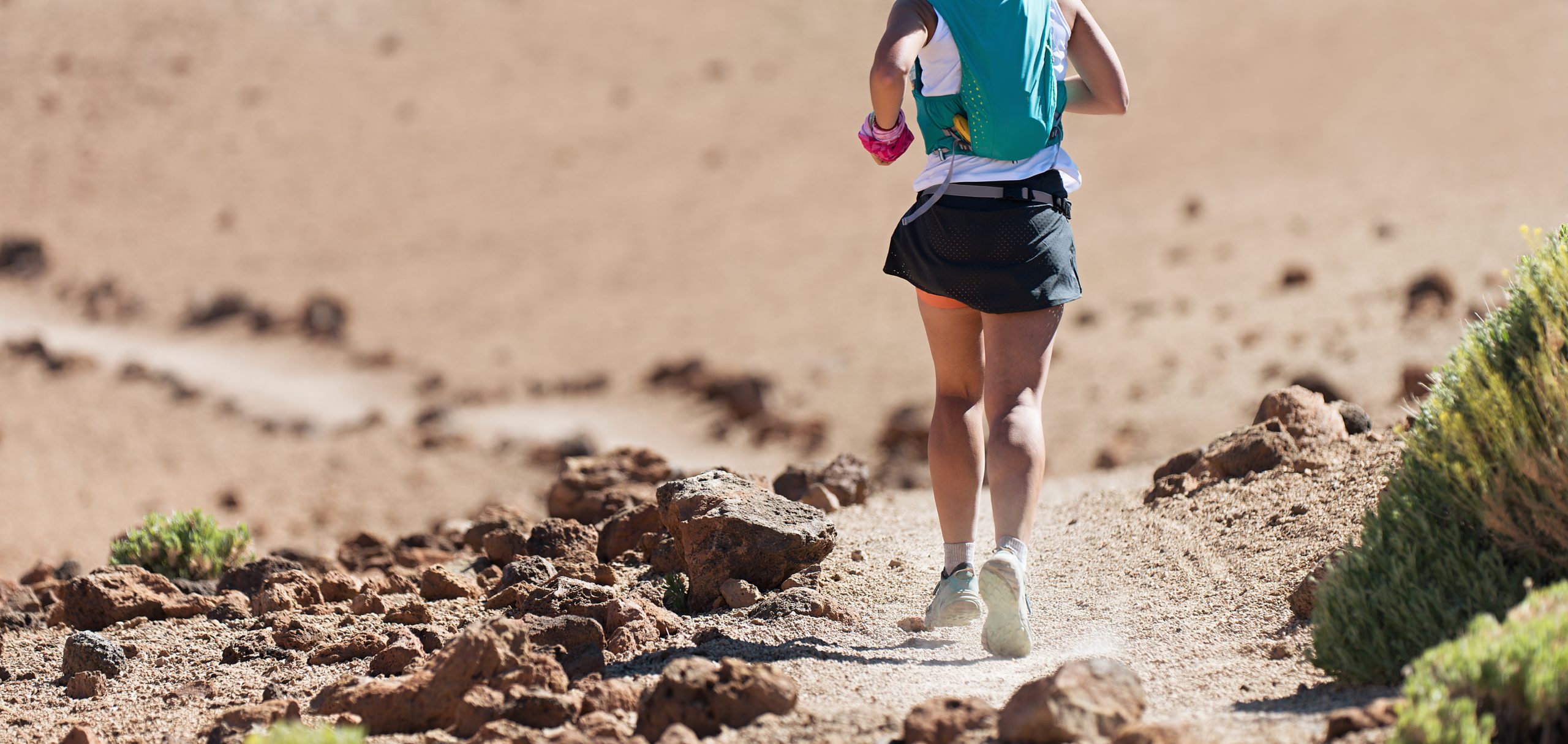Trail and Ultra Running Special: From Inspiration to Know-How
Welcome to the Trail and Ultra Running Special! Whether you’re new to trails and have never heard of ultrarunning or you’re a seasoned trail beast who has run conquered distances some don’t even like to drive, this one’s for you.
Written and edited by Pavlína Marek
Sure, roads are great, especially when they take you on a marathon adventure across the Golden Gate Bridge or through San Francisco’s most vibrant neighborhoods. We must know—after all, for 45 years, we’ve been putting on a race to showcase just that! However, the hearts of some of our runners and staff alike are lit on fire by more technical stuff; sweet, steep, rocky, rooty, dusty, dirty trails! Welcome to this collection of articles, films, and books to get you inspired and going; welcome to the trail and ultra running special.
The Inspo
Let’s jump right in; we begin with a local bang, one of the world’s most extreme, “unsanctioned, unhinged” running relay races. Ladies and gentlemen, here it comes:
California’s The Speed Project: an Underground Ultra that “few know about, fewer compete in and no entrant ever forgets” (Tom Ward for The RedBulletin)
“It began with a rumour. About an underground foot race starting at the beachfront of Santa Monica and finishing in Las Vegas. A race without sponsors, without rules, without even a website. Where no spectators are allowed and there’s no purse at the end – and yet it attracts some of the world’s best athletes, drawn by the promise of a unique trial of pace and perseverance. That rumour led to a name – The Speed Project, a moniker coined by the founder of the race, Nils Arend.”
While The Speed Project is both a trail run and, without a doubt, an ultra one, the next, more-local-to-us race is much shorter. In fact, it’s Short, Sweet, and Steep. And let’s put some emphasis on steep because this baby features flights of stairs.
The 111th Dipsea Race: A One-Hour Ultra (Jeffrey Stern for UltraRunning)
“In 1905, 16 years prior to the first Comrades Marathon, the world’s oldest organized ultramarathon, the Dipsea Race officially began… I’m certainly not proclaiming that Comrades and the 7.4-mile Dipsea are in any way connected, but I will say that chasing a Dipsea finish across the hallowed Mount Tamalpais in Marin County, California, is very much akin to running an ultramarathon. … The legacies of trail and ultrarunning are intrinsically tied.”
From a 1-hour ultra to a 1-week one, let’s leave California and go to Arizona. There, under the heat of the desert sun and in the company of saguaro cacti, a new challenge is brewing. This brain-child of Jamil Coury is not for the faint of heart; a grueling, demanding, and rewarding event full of ups and downs, literal and metaphorical.
Now, Let’s Go Really Far: Cocodona 250 (Aravaipa Running)
The year is 2021. It’s the first Monday morning of May and you’re standing together with other 175 runners at the start of the first-ever Cocodona 250 ultramarathon. You don’t know it yet but the winner, Michael Versteeg, will finish 3 days and 50 minutes from now. The last finisher will take 5 days and 3.5 hours. And 68 people will get that DNF (did not finish) mark. The heat and long, waterless miles will take you out even before the climbing does. The gorgeous Arizona desert will chew you up and spit you out—the worse for wear but the better for yourself. Welcome to the ultimate challenge.
Does Cocodona 250 sound, like, really long? Well, however unbelievable it may sound, the longest race in the world is more than 12 times longer!
3,100: Run and Become: Seeking Spiritual Enlightenment by Running in the World’s Longest Race (Kanopy)
The longest race in existence isn’t run on trails. It’s run around one block in New York City. Every year, “endurance runners who push themselves to the edge of physical and mental collapse.” Established by the great Sri Chinmoy, this run isn’t only about endurance; the runners who set out on this physical and spiritual journey “endeavor to challenge the boundaries of impossibility.”
To successfully complete the 3100: Run and Become, “people have to go beyond competitiveness and athletic prowess and … push themselves not for glory, but for spiritual enlightenment.”
Note: You can watch this film for free only on Kanopy. You’ll need your library or university card to be able to access the movie library.
A one-hour trail run or a one-month ultramarathon, there’s no minimum nor limit to how far you want to go. The only thing that matters is that you want to go. Have you never run more than a 5K and want to do a hundred miler now? No worries, you’re not crazy; our editor decided to run a hundred even before she started to run. (The culprit behind that was one unexpected walk-turned-run among the majestic redwood trees and a documentary by Brendan Leonard called How to Run 100 Miles.) All it’ll take for you to achieve your newly found goal is a lot of time, work, and miles!
Running Through the Wall: Personal Encounters with the Ultramarathon
Published in 2003, Running Through the Wall: Personal Encounters with the Ultramarathon is a collection of short essays from runners, everyday people and soon-to-be professionals alike. Nowadays, Ann Trason and Tim Twietmeyer might not be the biggest names out there.
Trason ran her first ultramarathon in 1985 and quietly left the sport in 2004. Nowadays, she volunteers at races, paces friends, and coaches athletes. ‘”This is my place now,” she said. “I want to give back to the community that’s given me so much,”‘ wrote Jill Homer in a profile she wrote about this runner for The Guardian.
Tim Twietmeyer spent 25 long years in the world of professional ultrarunning. In these 25 years, he ran the famous Western States 25 times. Every time, he finished in under 24 hours. In the master’s category (40+ age division), he holds the course record of 17 hours and 17 minutes. To ensure the continuation of the event, he also advocated for the Western States Trail to get the same protections as the Pacific Crest Trail.
“Read about the Grand Slam, about the times there were only 3 ultramarathon races in the entire US, about the infamous Barkley, about the will-breaking Massuten Mountain, and much more” in this great collection!
The Know-How
INTRIGUED? It’s time to join THE DARK SIDE!
Of course, there are a few intricacies to it. Not everybody is superhuman and putting in a huge amount of mileage can have some negative effects on your body if it’s not ready. Cross-training, strength training, and mobility work are all important parts of your journey to an ultra. However, it’s an incredibly rewarding process filled with joy, effort, and people who will become your friends for life.
Let’s Start with the Basics: Six Simple Things You Need to Know About Trail Running. (Pavlína Marek for the San Francisco Marathon)
At its core, trail running is simple. You just put on your shoes and go out there, as fast or slow as you want, for as long as you feel like, with as many or as few people as you enjoy. I believe that no checklists are needed in order for you to enjoy trail running. However, here are a few trail running basics for those of you who want to be more prepared. Let’s talk about Shoes, Strength, Speed, Sustenance, Sun & Snow, and Someone to run with.
Hills are an Integral Part of Trail and Ultra Running. How do You Prepare Your Legs for Mountain Trails? (Sean Rimmer for American Trail Running Association)
Trail races are generally slower than road races, especially when they include a lot of hills. While Mallory Richard contemplates how much slower hilly races are than their flatter counterparts in an article for IRunFar, Sean Rimmer tackled mountain trails as a whole in his article for ATRA’s Trail Times.
“… although it is an exciting time to train and explore the high country, the physical nature of mountain trails can be overwhelming to say the least.”

Group of people trail run with tall mountains in the background
Next on the List is Food: Nutrition for Trail Running (Becca Blumberg for the San Francisco Marathon)
There are some key differences between road and trail running that may impact your nutrition strategy. Trail is a whole different beast. The terrain is highly variable so it is much harder to predict pace. Usually, this means it takes significantly longer to cover the same distance. You may find yourself walking at times due to rough terrain. Races are also generally longer on trails than on the road. All of this means two things. One, you’ll need to get in more calories, and two, you’ll likely eat a much wider variety of foods. (Ever heard of Courtney Dauwalter setting the American record in 24-hour running on burritos and beer?)
And, Finally, Let’s Go Ultra: 5 Tips for Becoming an Ultramarathon Runner (Anja Hayes for UltrAspire)
“Congratulations! If you are reading this article, then that likely means you are considering starting your ultramarathon journey. As challenging as they are, ultramarathons are empowering races that benefit your physical health and strengthen your mentality. Starting out can be pretty scary, though. Luckily, UltrAspire’s Athlete team has some great advice for newcomers. Read below to see what they have to say.”
Aid Station Strategies for Your First Ultra (Darcie Murphy for Ultra Running Magazine)
Aid stations are a crucial part of any trail and ultra running event or race. They’re your chance to refill on water, food, and human contact—yes, after 10 hours in the dark where the only speck of light is that coming from your headlamp and the only human you meet is the little voice in your head (perhaps telling you that you can’t do it), you’ll crave the sight of humans more than the pickle juice. How you spend your time at an aid station can greatly impact the outcome of your race. Let Darcie Murphy walk you through your aid station game plan.
We can’t wait to see you out there—be it on the road or on the trail!


